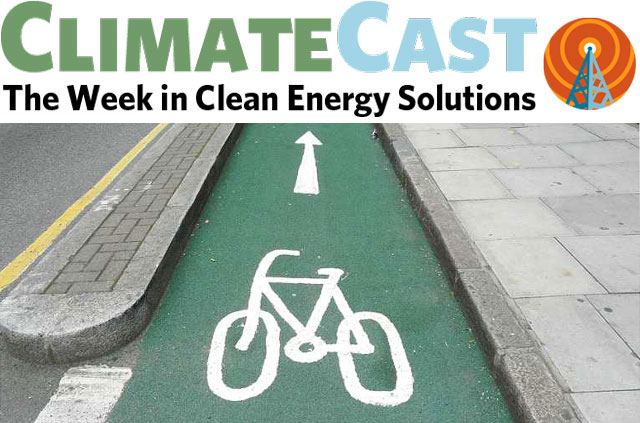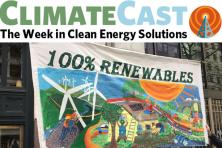Carbon pricing in the wind, from Chile to Canada |
|
Chile would become the second country in Latin America with a price on carbon, under a proposal from newly re-elected President Michelle Bachelet. Power plants would pay $5 per metric ton of carbon dioxide, plus taxes on other pollutants such as sulfur and nitrogen oxides. In Canada, the oil lobby said it could support a national carbon price, if the proceeds were used to encourage investment in new technologies. And in the Northwest, Sightline digested a report on the economics of a carbon tax in Oregon, and reviews the choices the state would face in crafting one. |
China leads world in renewable energy investment |
|
China surpassed the United States in clean energy investment for the second year in a row, said a report released last week by the Pew Charitable Trust. China invested $54 billion in 14 gigawatts of wind and 12 gigawatts of solar in 2013, while the U.S. spent $36 billion to install 4.3 gigawatts of solar and less than 1 gigawatt of wind. American wind investment plummeted following a rush to launch projects before a tax credit expired at the end of 2012. Worldwide, new solar capacity topped wind for the first time in over a decade, mainly due to lower equipment prices. |
Some internet firms boost green energy, others lag behind |
|
Greenpeace released its Clicking Clean report last week, rating internet firms for their progress in powering web traffic with green energy. Facebook, Google, and Apple won high marks for sourcing renewable electricity and pushing utilities to bring more green power onto their grids. Microsoft received a mediocre grade for relying too much on carbon offsets instead of actual renewable generation. Amazon — which hosts Netflix, Tumblr and other major websites — took fire for locating data centers in places where the grid is mostly coal-fired, and refusing to provide information about its power sources. |
IPCC pivots from cataloging impacts to considering solutions |
|
Ripples of the Intergovernmental Panel on Climate Change impacts report continued to spread last week, as numerous editorial boards used it as a basis to call for urgent action to cut carbon pollution. Risk was a common frame in opinion and news analysis, with writers arguing that lack of absolute certainty is no reason for inaction. This week, attention shifts to Berlin, where the third IPCC working group convenes to review what can be done to address the threat of climate disruption. American negotiators are reportedly pressing the panel not to overstate the costs or understate the additional benefits of cutting carbon emissions. |
Small-scale renewable energy gains ground |
|
The week saw several small steps forward for small-scale renewable energy. Oregon will now allow community groups and neighbors to invest together in renewable energy projects without going through cumbersome securities rules. In Vermont, some utilities had hit the cap on how much customer-generated renewable power they had to accept on their grid, so a new state law was passed to raise the cap from 4 to 15 percent. And in Britain, the Conservative energy minister said the government would encourage rooftop solar, rather than solar farms in the countryside, hoping to avoid the opposition that has plagued rural wind farms. |
Exxon insists its fossil reserves will be available to burn |
|
Responding to shareholder demands to consider the risk that some of its fossil fuel reserves will be “stranded” by limits on carbon emissions, ExxonMobil released a report last week dismissing the possibility. Although it is projecting that environmental regulations may raise prices $80 per ton of carbon dioxide, it insists that fossil fuels are too necessary to the economy for governments to restrict their use. Their stance drew criticism from activist and author Bill McKibben, who reads the firm’s position as a challenge to the climate movement to confront the oil giant’s claims of political muscle. |
Hydrogen fuel cells gain traction ... outside the auto sector |
|
Although progress has been meager toward George W. Bush’s 2003 vision of a hydrogen-powered fleet of fuel-cell cars, the technology has gained a foothold in several specialized applications in recent years. Wal-Mart is investing in hydrogen-fuel-cell forklifts, which are cheaper to operate than battery-powered alternatives. Data centers and telecom towers use them for back-up power because they are more reliable than petroleum-fired generators. And 70,000 homes in Japan installed fuel-cell power in the wake of energy shortages and rising prices that followed the Fukushima nuclear accident. As always, though, hydrogen is only as green as the energy used to generate it. |
Why is Vancouver’s carbon footprint so small? |
|
Vancouver, B.C., has the lowest carbon emissions per capita of any major city in North America, according to World Bank figures, and Grist set out to discover how they do it. For starters, carbon-free hydropower helps a lot. But Vancouverites shaved their already-low emissions by 9 percent since 2007, by offering residents appealing alternatives to driving in automobiles; creating attractive, dense neighborhoods downtown and along transit routes, and capturing energy from waste, be it methane from landfills or heat in sewage. The down-side? These measures make the city ever more appealing, which has made it less and less affordable. |
Can Africa leapfrog the carbon age? |
|
More than half of Africa’s 1 billion people lack electricity, but that doesn’t mean they need fossil fuels — or even a centralized grid — to get it. Cheaper solar panels, highly efficient LED lights, and the cost of connecting remote villages to transmission lines will make home- and village-scale renewables more practical. That’s where foreign energy aid should go, says commentator Julian Popov. There’s precedent with the African phone network, he says, whose build-out skipped right over landline technology. The continent’s half-billion mobile phones outnumber landlines 40 to 1. |
Bikers benefits from lane redesign, and a lift up the hill |
|
The nonprofit People for Bikes, which advocates protected bike lanes that are physically separated from the flow of motor traffic, is bringing its Green Lane Project to six new cities including Seattle, according to an article in Fast Company. Protected bike lanes can increase sales at nearby businesses, according to studies in both New York City and Portland, OR, which was among the project’s first-round cities in 2012. Trondheim, Norway, has gone even further in appealing to bikers: they’ve installed a “bike elevator” that powers cyclists up a 400-foot hill with cable-driven foot-plates that cyclists can lean on for a lift. |
Image

Chile floats carbon tax, China leads renewable investment



